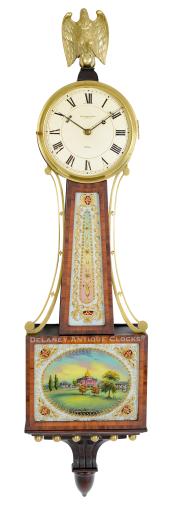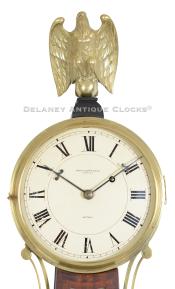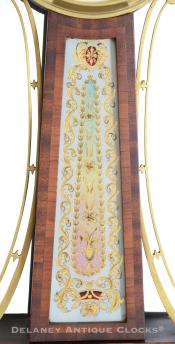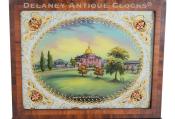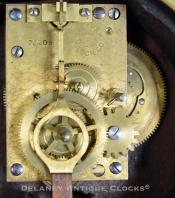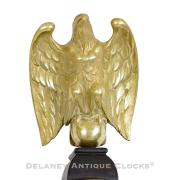A Waltham wall timepiece or banjo clock featuring tulip cross-banded frames and a painted scene of the Boston State House. 224025.
This fine Federal Massachusetts Timepiece, commonly called a “Banjo Clock” was made by the Waltham Clock Company of Waltham, Massachusetts, between 1914 and 1922 based on the number 7540D die-stamped on the movement’s front plate. This beautiful case form is listed in Waltham Clock catalogs as the model No. 1546 and initially sold for $85.90 in the first quarter of the twentieth century.
This is an exceptional clock. Waltham made several clocks that share the same formatting. This example fits to the best of what was available from the factory. This includes brass balls on the presentation bracket compared to the mahogany versions usually found in this location. The mahogany frames are cross-banded with a selection of tulipwood. This wood is lighter in color than the mahogany and has a strong grain pattern. The color contrast of the two woods is excellent, only masked by the original finish, which has darkened over time. These frames are the most desirable wood-formatted options of the Waltham offerings. They support the two colorfully hand-painted tablets. These are reverse painted or painted from the back and demonstrate excellent artistic skills. Both tablet themes are familiar to us, yet they are special in that the scenes are presented in a higher level of detail, and the colors are more attractive. The throat features a traditional theme for this form. The gilt designs are finely formed and intricate. A vine of flowers terminates in the urn in the center panel. This multi-colored panel features a transition of color from light blue through a field of yellow and ending in pink. The lower tablet depicts a popular view of the Boston State House. The view is from the vantage point of the pasturelands that are now part of Boston Common. Architect Charles Bulfinch designed the Boston State House, and is still today a significant Boston landmark. Construction began in 1795 and was completed in 1798. This building is positioned on top of Beacon Hill on land that John Hancock once owned and was visible from miles away until the city of Boston grew up around it. To the left of the State House is John Hancock’s residence. Unfortunately, Hancock’s home was torn down in 1863. This particular glass is exceptional. The details are very well done. The buildings are in proportion, the trees are full, and the coloring is exceptional. The sky features many colors, including red, green, purple, and yellow. Medallions are positioned in each corner.
Brass side arms, which serve as decorative elements, are fitted on either side of the throat section. The dial bezel, also brass, is fitted with glass to protect the dial. Behind the bezel is the dial.
The iron dial is slightly convex in shape. It is painted in the traditional formatting, having a segmented minute ring and Roman-style hour numerals. The Retailer’s name, SHREVE, CRUMP & LOW CO. / BOSTON, is below hour XII. The maker’s name, WALTHAM, is painted above hour VI. Steel hands display the time.
A large cast brass eagle finial, a common decorative element in Federal Massachusetts Timepieces, is fitted on a plinth at the top of the case. The eagle symbolizes strength and freedom and adds a patriotic touch to the clock's design.
The brass movement is secured to the case with diagonal-positioned machined screws to a brass plate that is mounted to the backboard. The weight-driven movement is designed to run for eight days on a wind. The quality is outstanding. It features heavy brass plates decorated with a damascene design, maintaining power and a Geneva stop winding mechanism. The front plate is die-stamped with the serial number “7540D” on the left and “Waltham Clock CO. U.S.A.” on the other side.
This clock measures approximately 41 inches long overall.
Inventory number 224025.
The Waltham Clock and Waltham Watch Companies, in their various forms, have been synonymous with quality timepieces. The Company was first established in Waltham, Massachusetts, in January of 1897 as the Waltham Clock Company. Their products, known for their excellent quality, included hall, shelf, and then wall clocks. In 1913, they merged with the watchmaking giant Waltham Watch, but continued to produce clocks under the Waltham Clock name until 1923, when the name was changed to the Waltham Watch and Clock Company. In 1925, the name was changed again to the Waltham Watch Co. The production of pendulum clocks is reported to have ceased around 1930.

